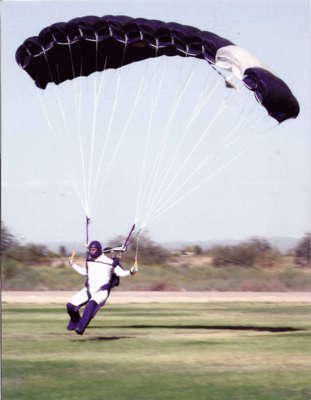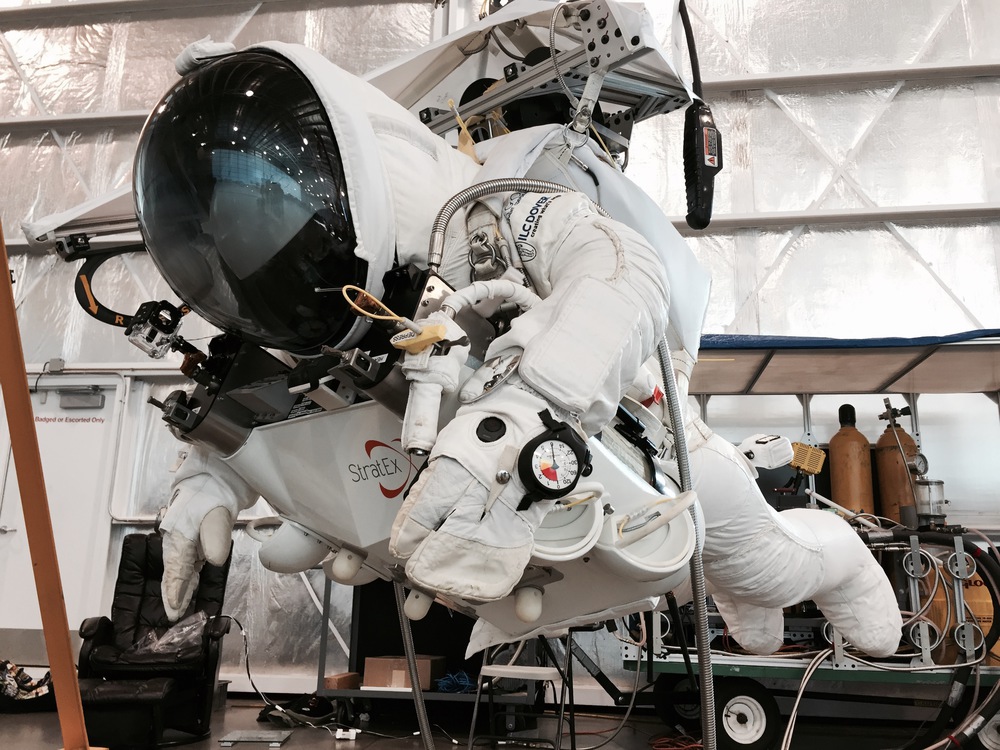Recommended Posts
mnealtx 0
If the jumper doesn't read the manual and know that the Cypres is going to trip if they hit 78mph vertical speed under 750 feet, then the jumper is *WRONG*, in my opinion.
I would fully expect Airtec to notify users if there was a problem or recall with the units... I would not expect them to send out a reminder to users to not exceed the firing parameters under canopy.
QuoteAirtec needs (and in fact needed when they started to look into a swoop version) to update the F---ING MANUAL.
Update their manual for...? A unit that is still in development?
I love you, Shannon and Jim.
POPS 9708 , SCR 14706
Remster 24
QuoteUpdate their manual for...?
To remove the statement that a unit cannot be fired by a hookturn.
EDIT: Airtec states its more ten just hitting 78 mph at 750 feet, that they have a complex algorithm to check stuff (I use stuff since they are quite private about what it is).
tsisson 0
As some people choose to push the performance envelopes of their canopies, speeds are being generated that approach that of freefall.
Common sense to me dictates that this could be a problem when jumping an AAD.
I think we need to take some personal responsibility for our actions and choices within the sport. We all must learn from our tragedies and experiences...so hopefully this latest incident will help us develop safer procedures and equipment within the swooping discipline.
Perhaps the short term solution is to turn an AAD off before executing super high performance maneuvers under small canopies, now that we know it can prove to be a problem.
Hooknswoop 19
Quote
Basically they are saying publicly that you can get a cypres to fire, but as far as they know you need a VERY extreme canopy (ie VX 46) to do it. There results from the VX 60 didn't cause it to fire.
Right, but Wingloading and manuevers play a role. You can't simply say a VX-46 will cause it to fire and a VX-60 won't. It isn't that simple. For example, even after these tests, Airtec could not tell me if my Cypres would fire or not.
Derek
Hooknswoop 19
QuoteIf the jumper doesn't read the manual and know that the Cypres is going to trip if they hit 78mph vertical speed under 750 feet, then the jumper is *WRONG*, in my opinion.
I was well aware of the parameters Airtec says will cause the Cypres to fire. Even Airtec could not tell me if it would fire at my WL and under my VX. If the manufacturer can't tell me, how am I supposed to figure it out from RTFM?
People keep saying all you have to do is RTFM, but that is no help. If it was, then Airtec could answer if a certain canopy at a certain WL, landing at a certain elevation at a certain density altitude could fire the Cypres. They can't. How is a jmper supposed to be able to decide if they are at risk of firing their Cypres then?
Quote
Update their manual for...? A unit that is still in development?
No, remove or amend the statement that hook turns under small canopes will not fire the Cypres. Because, clearly, that is no longer true. So RTFM will set the jumper up for failure.
Airtec knew this issue was coming for a long time.
Derek
Andy9o8 0
Since the manufacturer is usually in the best position to possess the most current information about its product, then the manufacturer has a responsibility to provide that information to the consumer as quickly and as prominently as possible. (And “prominent” means more than just burying a generic, self-serving disclaimer in a manual.) The Airtec manual seems to be, at best, ambiguous about whether hi-speed HP canopy maneuvers may or may not activate the Cypres. However, the generally-accepted standard is that ambiguities, especially about safety, in product documentation issued by a manufacturer or distributor are almost always resolved in favor of the consumer.
Bottom line: jumpers must use their Cypres responsibly, but Airtec should have issued a clear and prominent service bulletin as soon as they appreciated this particular hazard -- and that means at least months ago (and possibly as early as 2001). Unfortunately, manufacturers acting too slowly (or not at all) to issue safety service bulletins is also not a new concept.
Don’t get mad at me; I didn’t invent these standards, I’m just the messenger.
But that doesn't absolve the manufacturers of their responsibility. One of the things that is so great about skydiving, is that we look out for each other. Sure, when it comes down to it, only you are truly responsible for your skydive, but still, we look out for each other. That should include the manufacturers too.
Methane Freefly - got stink?
Hooknswoop 19
QuoteCommon sense to me dictates that this could be a problem when jumping an AAD.
People say RTFM. Well the manual says you can't fire a Cypres with a small canopy. So if you RTFM, you think you are OK. So now RTFM isn't enough, you have to know more than the manufacturer apparently.
QuotePerhaps the short term solution is to turn an AAD off before executing super high performance maneuvers under small canopies, now that we know it can prove to be a problem.
Now that we know it can prove to be a problem? Airtec knew in 2001. It was a matter of time before it caused a fatality.
If Airtec had changed the maual and release a statement along the lines of small canopies may cause the Cypres to fire during high perfomrance manuevers and is not recommended to be used during such manuevers, I would agree that they would be blameless. But, they knew it could be an issue in 2001 when I talked to them.
Derek
billvon 2,384
I don't think those are the same thing.
You're a rigger. What would you say to a jumper who asked "is there a chance this harness will disintegrate from a hard opening if I use the reserve?" Would you inspect the harness and then, if it was in good shape, guarantee it would never fail? That's not the same as saying "it may fail at some point but the odds are very much against it."
Quote
Right, but Wingloading and manuevers play a role. You can't simply say a VX-46 will cause it to fire and a VX-60 won't. It isn't that simple.
Well of course WL and manoeuvres play a part. Which is why the WL is given on the www site I posted. I didn't mention the specifics in my post for brevity.
The jumper was Luigi Cani, and they were trying to get it to fire so they undoubtedly tried several different types of approach.
Quote
For example, even after these tests, Airtec could not tell me if my Cypres would fire or not.
Could not or would not?? You were asking them to put there neck on the line. If you read the label/manual for any bit of skydiving equipment it usually says the manufacturers are not responsible for any loss of life etc. So if they did state that you could not get it to fire on your VX, and it did...
I doubt you'll find anyone in this industry that would put there neck on the block in such a fashion. Besides the person you spoke to would probably not be able to speak for the company, even if they had legal representation present.
Hooknswoop 19
QuoteI don't think those are the same thing.
Sure they are, they didn't know if I could fire it or not. They suspected I could, but seemd afraid to say so. The conversation was very odd and they clearly didn't want to discuss it at all. I couldn't even get them to answer, "Could I possibly fire it during a landing?" I asked if I could jump a data logger so that I could find out for sure, but they weren't interested, they wanted to charge me to use it. Basically, I couldn't get any answers out of them, so I got rid of the Cypres.
They knew in 2001 that small canopies could cause a Cypres to fire. Everyone has seen the trend of more people jumper smaller and smaller canopies. It was a matter of time before they started to fire.
I felt that I was better off without the Cypres because of the risk it may fire from the small canopy was greater than the risk of actually needing the Cypres. I went against what the manual said.
QuoteYou're a rigger. What would you say to a jumper who asked "is there a chance this harness will disintegrate from a hard opening if I use the reserve?" Would you inspect the harness and then, if it was in good shape, guarantee it would never fail? That's not the same as saying "it may fail at some point but the odds are very much against it."
If the harness has some serious wear that made it a possibility that it may fail on a hard reserve deployment, then it was a real possibility. Especially if I was aware of a similar incident.
If the harness is good, then I would tell them, the odds are almost zero because the reserve will come apart before the harness, and if it doesn't,t hen you'll come apart and it won't matter.
If I knew that that particular harness and reserve combination could cause the harness to fail, I would tell them so.
Derek
Hooknswoop 19
QuoteCould not or would not??
Would not. I didn't want to die because my Cypres fired thinking it was saving me.
QuoteYou were asking them to put there neck on the line.
My neck was already on the line. I wanted to know just how far my neck was out.
QuoteIf you read the label/manual for any bit of skydiving equipment it usually says the manufacturers are not responsible for any loss of life etc. So if they did state that you could not get it to fire on your VX, and it did...
I did read the manual, which states that small canopies won't fire a Cypres. When questioned, Airtec didn't want to stand behind that statement because they know it was not longer true, in 2001.
Clearly it doesn't take a very small canopy to fire a Cypres. A Cypres may misfire at any time, that is accepted. But if someone is generating the speeds for the time necessary to make it fire, that is not a misfire or malfunction. How is a jumper supposed to now that they could cause the Cypres to fire? Especially when the manual says they can’t?
QuoteI doubt you'll find anyone in this industry that would put there neck on the block in such a fashion. Besides the person you spoke to would probably not be able to speak for the company, even if they had legal representation present.
Then they should have said, “We don’t know. It may fire or it may not. Use at your own risk.”
QuoteI doubt you'll find anyone in this industry that would put there neck on the block in such a fashion.
They did exactly that with this statement:” Our previous statement that "it is not possible to safely perform such radical maneuvers below 750 feet and activate CYPRES, as even if a jumper reaches 78 mph vertical speed for a brief amount of time, it will not activate" has been super ceded by new techniques involving a small handful of the best of the best canopy pilots. For them it is now possible to sustain vertical speed in excess of 78 mph for an extended period of time, and land safely.”
That statement should have come out a long time ago, not a couple of days after not the first incident, but after the first fatality.
They should investigate further and come up with a guide as to who is at risk and who isn’t. The consumer needs that information to make an educated decision about whether or not they can have a Cypres in their reserve container.
Derek
Quote
Even with extreme maneuvers during exit and in freefall, CYPRES will cope with it. Whatever you can think of under canopy like stalls, spiral turns, down planes, hookturns with the smallest canopies as well as any CRW, CYPRES will analyze these movements without problems. It won't interfere with any normal activities while skydiving.
well, looks to me like they did warn us in the manual, read the last sentence closely - not sure if this sort of thing (multiple 360s starting above 1500') is a "normal" mainstream jump activity, at least yet! But, yes, seems like now it is time for an update to the manual given the latest in canopy piloting skills.
Hooknswoop 19
Quotenot sure if this sort of thing (multiple 360s starting above 1500') is a "normal" mainstream jump activity, at least yet!
Really? I was doing spirals through 1,500 feet from early on. The statement specially says "Whatever you can think of under canopy......with the smallest canopies" They knew this wasn't true when they got Luigi got it to fire years ago.
Derek
FrogNog 1
The doc seemed to say:
1. If Cypres thinks you're in freefall (specs given), it may activate your reserve.
2. You can screw around under canopy all you want, and you won't make the Cypres think you're in freefall.
We now know that item 2 is not true, but item 1 is still true.
The answer is, as Amazon likes to say, "don't scare your Cypres". Don't let it think you're in freefall when you're under canopy.
And if someone's landing approach looks like freefall to Cypres from a mathematical point of view, the potential result is predictable.
I regret the death(s) (and and injuries), but the device is doing a good job of satisfying its main purpose (saving no-pulls) with acceptable additional risks. (You may not find these risks acceptable, but thankfully in most cases you have a choice whether to use the device.)
I don't think Airtec did anything wrong by not earlier and louder mentioning they knew or suspected canopy pilots could scare Cypres and that they were working on another version. The reason I'm not on Airtec's case is it's not their job to keep us safe; they just make the best airbag they can for the money we'll pay.
-=-=-=-=-
Pull.
billvon 2,384
> zero because the reserve will come apart before the harness, and if
>it doesn't,t hen you'll come apart and it won't matter.
And if they then hooked a load to it, took it out the back of a C-130 and deployed at 160kts? If that destroyed a friction adapter, would you be liable for giving bad advice? I suspect your reply would be "that's not how it's designed to be used, so you can't expect my advice to be accurate."
The problem here is that the cypres was not designed with very high speed swoops (or wingsuit flight) in mind. They have told you (and others) that there _may_ be a problem with the cypres under certain conditions with small canopies, very aggressive swoops etc. Their one failure, in my opinion, was in using overly strong language in the manual that said it would never have a problem under canopy. Jumpers who were following only the manual may have been misled by its assurances. Jumpers who follow the sport more closely (as you did) knew that there were potential problems.
Hooknswoop 19
QuoteThey have told you (and others) that there _may_ be a problem with the cypres under certain conditions with small canopies, very aggressive swoops etc.
But that is just it, they didn't tell me (or anyone else)that. Not until yesterday when they updated their web page did they say that. up until yesterday, after some misfires and immediately following the first fatality, they finally admitted what they have known for along time. If they weren't aware there was a proble, why start designing a 'swooper' version?
We knew it fired at 78 mph at 750 ft-103 ft. We knew it could not be fired by small canopies or aggressive canopy flight. Anything beyond that was speculation.
Quotethat's not how it's designed to be used
But, for a Cypres, that is how it was designed to be used, "whatever you can think of"
So why didn't they issue a statement sooner? Like 3 years ago? If I could see this coming, how could Airtec miss it?
Derek






.thumb.jpg.4bb795e2eaf21b8b300039a5e1ec7f92.jpg)
Airtec needs (and in fact needed when they started to look into a swoop version) to update the F---ING MANUAL.
Share this post
Link to post
Share on other sites